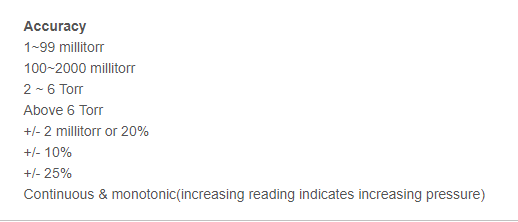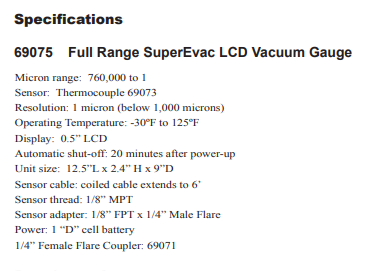Curious to know if this vacuum software will display the vacuum in scientific notation. Very cool idea for little money.
theres more detailed coding and wiring info at this link: MKS 901p - Fusor Forums
Awesome! Thanks for the link. I love this place.
It is setup to calculate the number without scientific notation but it does show the response from the sensor which is in sci notation. It would be easy to add into it. I’m in a little bit of a lul at the moment without much anything to process for a bit I don’t end up messing with the equipment as much.
Just ordered everything from Amazon and eBay. I’ll attempt to wire it up with proper breakout boxes and clear user friendly how-to on top of @gonzo guide for others to follow. Fired up our pump today and did initial pull to find the gauges that came with my roto and small reactor sucks donkey dick.
nice thanks bud ! appreciate it, literally bookmarked this last week lol def on my agenda
I just picked up one of these used. $50 shipped. I was getting depressed over the cost of quality sensors.
Manual
I hope you know these are the least accurate sensors on market. Just use a general refrence. The manual says they are off by 15-20%.
MicroPirani
Accuracy (1) (N2) 5×10-4 to 1x10-3 Torr: ±10% of reading
1×10-3 to 100 Torr: ± 5% of reading
100 Torr to Atm.: ± 25% of reading
Sub 1 Micron is +/- 10%.
from 1 micron to 100 torr is 5%.
Im not even gonna mention the number above 100 Torr as none of us are looking at numbers in that range.
Just wondering where you got your numbers from? Does the Bullseye or similar devices have even the capability to go below 1 micron?
Can you please explain the differences in why these piezo senors are worse then whats found on my bullseye?
He’s talking about the yellow jackets. They are within 20% same as a bullseye. That’s due to the thermocouple gauge yellow jacket sources. They can easily be the same accuracy as a bullseye or better if you use a calibrated agilent sensor.
Pirani 901 is far more accurate.
From bullseye website:
Accuracy
1~99 millitorr
100~2000 millitorr
2 ~ 6 Torr
Above 6 Torr
+/- 2 millitorr or 20%
+/- 10%
+/- 25%
You are incorrect those are fluffed up readings. Those stinger guages are bottom of the barrel. You won’t convince me. I own nist certified guages. I don’t cheap out on sensors.
Bullseye is way more accurate. We order ours with the upgraded baffle sensor, and that’s why ours cost a bit more than the stock cheapo one’s. You can order then with different guage heads. Yellow jacket and stinger type guage heads are considered the bottom of the barrel in the market. It’s hard to tell people your vacuum rating when you can’t validate your reading. I have nist certified test benches at work. You’d be shocked side by side what those stingers really read compared to a clean guage.
no trying to convince you. your the expert. Im trying to learn the difference. can you please tell us about your upgraded baffle sensor?
Can your unit go below 1 micron? and when you refer to the stinger type gauge are you referring to the mini pirani i referenced. once again im not an expert in this at all; just trying to understand the differences so i can own the best equipment i can afford.
All guages have a range. Each is accurate.
A guage that read below 1 micron I. The -4 to -8 decade will never read at or above 1 micron correctly.
You use different guages.
The ordinary ranges bias to the results of the american vacuum society tests are high range, mid range, high vacuum range and ultra high vacuum. Each range has a different sensor head that works great with them.
We use on put 1 micron ranges the 536 baffled sensor that can be cleaned.
the gauge is just a reader. the magic happens in the sensor. the yellow jacket and bullseye both take a thermocouple sensor and convert the millivolt reading to a number. the gauge readout is not what determines the accuracy.
yes they have a working range. and the bullseye readout is the same range as the yellow jacket.
Bullseye: 
YJ: 
You are confusing what I said bs what I meant. The guage screen is software bases and can be effectively off as well. The reading is taken of guage head or sensor. The more accurate this guage head and sensor is the better.
I’m not worried about the accuracy. This is a budget sensor.
The documentation is top notch. It doesn’t matter how accurate a sensor is if I can’t find a data sheet to figure out what the sensor is trying to tell me.
The bigger issue with the sensor is
I ordered one of these breakout boards to make the sensor connection easier to work with.
Oiyagai DB15 3+9 D-SUB VGA Female 3Row 15Pin Connector Adaptor Screw Terminal Breakout Board Free Welding Amazon.com
are you guys using a bullseye with a custom bios or software? Never did i say a Yellow jacket is better than a bullseye. obviously a bullseye is a better gauge if nothing more than the ability to calibrate a sensor. but a YJ can be a very useful reader that actually reads any varian/agilent 531 or 536 sensor. and they are 100 bucks used on ebay
bro that pirani 901 sensor is in a different league than the bullseye thermocouple sensors. the bullseye varian 531/536 sensors dont even compare.

